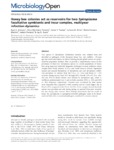Por favor, use este identificador para citar o enlazar este ítem:
http://www.alice.cnptia.embrapa.br/alice/handle/doc/987566Registro completo de metadatos
| Campo DC | Valor | Lengua/Idioma |
|---|---|---|
| dc.contributor.author | SCHWARZ, R. S. | pt_BR |
| dc.contributor.author | TEIXEIRA, E. W. | pt_BR |
| dc.contributor.author | TAUBER, J. P. | pt_BR |
| dc.contributor.author | BIRKE, J. M. | pt_BR |
| dc.contributor.author | MARTINS, M. F. | pt_BR |
| dc.contributor.author | FONSECA, I. | pt_BR |
| dc.contributor.author | EVANS, J. D. | pt_BR |
| dc.date.accessioned | 2014-07-26T06:56:32Z | - |
| dc.date.available | 2014-07-26T06:56:32Z | - |
| dc.date.created | 2014-06-03 | pt_BR |
| dc.date.issued | 2014 | pt_BR |
| dc.identifier.citation | Microbiology Open, v. 3, n. 3, p. 341-355, 2014. | pt_BR |
| dc.identifier.uri | http://www.alice.cnptia.embrapa.br/alice/handle/doc/987566 | pt_BR |
| dc.description | Two species of Spiroplasma (Mollicutes) bacteria were isolated from and described as pathogens of the European honey bee, Apis mellifera, ∼30 years ago but recent information on them is lacking despite global concern to understand bee population declines. Here we provide a comprehensive survey for the prevalence of these two Spiroplasma species in current populations of honey bees using improved molecular diagnostic techniques to assay multiyear colony samples from North America (U.S.A.) and South America (Brazil). Significant annual and seasonal fluctuations of Spiroplasma apis and Spiroplasma melliferum prevalence in colonies from the U.S.A. (n = 616) and Brazil (n = 139) occurred during surveys from 2011 through 2013. Overall, 33% of U.S.A. colonies and 54% of Brazil colonies were infected by Spiroplasma spp., where S. melliferum predominated over S. apis in both countries (25% vs. 14% and 44% vs. 38% frequency, respectively). Colonies were co-infected by both species more frequently than expected in both countries and at a much higher rate in Brazil (52%) compared to the U.S.A. (16.5%). U.S.A. samples showed that both species were prevalent not only during spring, as expected from prior research, but also during other seasons. These findings demonstrate that the model of honey bee spiroplasmas as springtime-restricted pathogens needs to be broadened and their role as occasional pathogens considered in current contexts. | eng |
| dc.language.iso | eng | pt_BR |
| dc.rights | openAccess | pt_BR |
| dc.subject | Flower microbe communities | pt_BR |
| dc.subject | Host-parasite interaction | pt_BR |
| dc.subject | Microbial prevalence | pt_BR |
| dc.subject | Symbiont | pt_BR |
| dc.subject | Temporal survey | pt_BR |
| dc.title | Honey bee colonies act as reservoirs for two Spiroplasma facultative symbionts and incur complex, multiyear infection dynamics. | pt_BR |
| dc.type | Artigo de periódico | pt_BR |
| dc.date.updated | 2014-07-26T06:56:32Z | pt_BR |
| dc.subject.nalthesaurus | Spiroplasma | pt_BR |
| dc.format.extent2 | 15 p. | pt_BR |
| riaa.ainfo.id | 987566 | pt_BR |
| riaa.ainfo.lastupdate | 2014-07-25 | pt_BR |
| dc.identifier.doi | https://doi.org/10.1002%2Fmbo3.172 | eng |
| dc.contributor.institution | RYAN S. SCHWARZ, Bee Research Lab, USDA; ERICA WEINSTEIN TEIXEIRA, APTA-SP; JAMES P. TAUBER, Bee Research Lab, USDA; JULIANE M. BIRKE, Bee Research Lab, USDA; MARTA FONSECA MARTINS, CNPGL; ISABELA FONSECA; JAY D. EVANS, Bee Research Lab, USDA. | pt_BR |
| Aparece en las colecciones: | Artigo em periódico indexado (CNPGL)  | |
Ficheros en este ítem:
| Fichero | Descripción | Tamaño | Formato | |
|---|---|---|---|---|
| ArtigoMartaHoneyBeembo3172.pdf | 366,25 kB | Adobe PDF |  Visualizar/Abrir |









